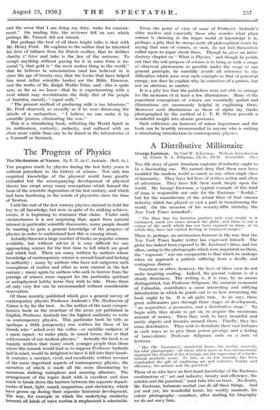The Progress of Physics
The Mechanism of Nature. By E. N. da C. Andrade. (Bell. Os.).
THE progress made by physics during the last forty years is without precedent in the history of science. Not only has empirical knowledge of the physical world been greatly extended but the accompanying development of physical theory has swept away many conceptions which formed the basis of the scientific dogmatism of the last century, and which had been hardening in the minds of physicists since the time of Newton.
Until the end of the last century physics claimed to hold the key to all knowledge, but now, in spite of its striking achieve- ments, it is beginning to renounce that claim. Under such circumstances it is not surprising that, apart from natural interest in particular scientific discoveries, many people should be wanting to gain a general knowledge of the progress of physics in order to understand how this is coming about.
Actuallythereare a large number of books on popular science available, but without advice it is very difficult for one approaching science for the first time to tell which are good and which bad. There are many written by authors whose knowledge of contemporary science is second-hand and lacking in authority ; many by authors who have not outgrown such conceptions of matter and ether as were current in the last century ; many again by authors who seek to borrow from the prestige of science some support for the particular spiritual or metaphysical hobby horse they wish to ride. From them all only very few can be recommended without considerable reservation.
Of those recently published which give a general survey of contemporary physics Professor Andrade's The Mechanism of Nature is by far the best. As the author of the most compre- hensive book on the structure of the atom yet published in English, Professor Andrade has the highest authority to write on contemporary physics. This particular book he tells us (perhaps a little pompously) was written for those of his friends who " asked over the coffee—or suchlike endpiece of a spare repast—to make plain, in round terms, this or that achievement of our modern physics." Actually the book is so happily written that many much younger people than those whom this remark would lead us to suppose Professor Andrade had in mind, would be delighted to have it fall into their hands. It contains a succinct, vivid, and excellently written account of the more important aspects of contemporary physics, the narrative of which is made all the more illuminating by numerous striking metaphors and amusing allusions. The arrangement of the topics dealt with is excellent and does much to break down the barriers between the separate depart- ments of heat, light, sound, magnetism, and electricity, which have grown up during their separate historical development. The way, for example in which the underlying similarity between all kinds of wave motion is emphasised is admirable,
From the point of view of some of Professor Andrade's older readers and especially those who wonder what place science is claiming in the larger world of knowledge it is, perhaps, a pity that he sweeps aside all philosophical issues by saying that men of science, as such, do not feel themselveS called upon to argue about them. Though he gives an intro- ductory chapter on What is Physics," and though he points out that the sole purpose of science is to bring as wide a range of observed phenomena as possible under the scope of one general principle, he carefully avoids all reference to the difficulties which arise over such concepts as that of potential energy, nor does he explain why he conceives of a proton, but not an electron, as matter.
It is a pity too that the publishers were not able to arrange for the inclusion of at least a few illustrations. Many of the important conceptions of science are essentially spatial and illustrations are enormously helpful in explaining them. Moreover such illustrations as those of alpha ray tracks photographed by the method of C. T. R. Wilson provide a wonderful insight into atomic processes.
Such criticisms are however of minor importance and the book can be heartily recommended to anyone who is seeking a stimulating introduction to contemporary physics.
































 Previous page
Previous page